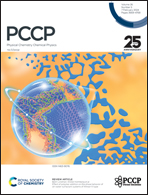Deciphering the photophysical properties of naphthalimide derivatives using ultrafast spectroscopy†
Abstract
Naphthalimide derivatives composed of donor–acceptor type structures hold significant promise across a wide range of applications. Here, the solvent polarity and viscosity controlled excited-state dynamics of a naphthalimide derivative with a donor–acceptor structure were studied using multiple spectroscopic techniques. From the stationary spectroscopic investigations, large Stokes shift and low fluorescence quantum yield were observed with increasing the solvent polarity, suggesting a more polar excited state relative to the ground state, which is evidenced by the Lippert–Mataga relationship. We also observe an enhanced fluorescence with a prolonged lifetime in a more viscous solution due to the restriction of excited-state molecular rearrangement. These observations result from the emerged twisted intramolecular charge transfer (TICT) state. The ultrafast spectroscopy studies further unravel a solvent polarity dependent excited state evolution from the intramolecular charge transfer state to the TICT state, revealing that the TICT state can be populated only in strong polar solvents. Control experiments by tuning the solvent viscosity in ultrafast experiments were employed to verify the excited state molecular rearrangement subsequently. These observations collectively emphasize how fine-tuning the photophysical properties of naphthalimide derivatives can be achieved through strategic manipulation of solvent polarity and viscosity.



 Please wait while we load your content...
Please wait while we load your content...